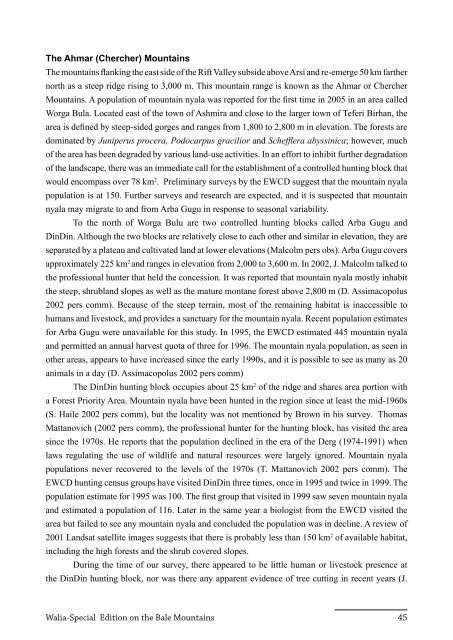Walia Special Edition on the Bale Mountains (2011) - Zoologische ...
Walia Special Edition on the Bale Mountains (2011) - Zoologische ...
Walia Special Edition on the Bale Mountains (2011) - Zoologische ...
You also want an ePaper? Increase the reach of your titles
YUMPU automatically turns print PDFs into web optimized ePapers that Google loves.
The Ahmar (Chercher) <strong>Mountains</strong><br />
The mountains flanking <strong>the</strong> east side of <strong>the</strong> Rift Valley subside above Arsi and re-emerge 50 km far<strong>the</strong>r<br />
north as a steep ridge rising to 3,000 m. This mountain range is known as <strong>the</strong> Ahmar or Chercher<br />
<strong>Mountains</strong>. A populati<strong>on</strong> of mountain nyala was reported for <strong>the</strong> first time in 2005 in an area called<br />
Worga Bula. Located east of <strong>the</strong> town of Ashmira and close to <strong>the</strong> larger town of Teferi Birhan, <strong>the</strong><br />
area is defined by steep-sided gorges and ranges from 1,800 to 2,800 m in elevati<strong>on</strong>. The forests are<br />
dominated by Juniperus procera, Podocarpus gracilior and Schefflera abyssinica; however, much<br />
of <strong>the</strong> area has been degraded by various land-use activities. In an effort to inhibit fur<strong>the</strong>r degradati<strong>on</strong><br />
of <strong>the</strong> landscape, <strong>the</strong>re was an immediate call for <strong>the</strong> establishment of a c<strong>on</strong>trolled hunting block that<br />
would encompass over 78 km2 . Preliminary surveys by <strong>the</strong> EWCD suggest that <strong>the</strong> mountain nyala<br />
populati<strong>on</strong> is at 150. Fur<strong>the</strong>r surveys and research are expected, and it is suspected that mountain<br />
nyala may migrate to and from Arba Gugu in resp<strong>on</strong>se to seas<strong>on</strong>al variability.<br />
To <strong>the</strong> north of Worga Bulu are two c<strong>on</strong>trolled hunting blocks called Arba Gugu and<br />
DinDin. Although <strong>the</strong> two blocks are relatively close to each o<strong>the</strong>r and similar in elevati<strong>on</strong>, <strong>the</strong>y are<br />
separated by a plateau and cultivated land at lower elevati<strong>on</strong>s (Malcolm pers obs). Arba Gugu covers<br />
approximately 225 km2 and ranges in elevati<strong>on</strong> from 2,000 to 3,600 m. In 2002, J. Malcolm talked to<br />
<strong>the</strong> professi<strong>on</strong>al hunter that held <strong>the</strong> c<strong>on</strong>cessi<strong>on</strong>. It was reported that mountain nyala mostly inhabit<br />
<strong>the</strong> steep, shrubland slopes as well as <strong>the</strong> mature m<strong>on</strong>tane forest above 2,800 m (D. Assimacopolus<br />
2002 pers comm). Because of <strong>the</strong> steep terrain, most of <strong>the</strong> remaining habitat is inaccessible to<br />
humans and livestock, and provides a sanctuary for <strong>the</strong> mountain nyala. Recent populati<strong>on</strong> estimates<br />
for Arba Gugu were unavailable for this study. In 1995, <strong>the</strong> EWCD estimated 445 mountain nyala<br />
and permitted an annual harvest quota of three for 1996. The mountain nyala populati<strong>on</strong>, as seen in<br />
o<strong>the</strong>r areas, appears to have increased since <strong>the</strong> early 1990s, and it is possible to see as many as 20<br />
animals in a day (D. Assimacopolus 2002 pers comm)<br />
The DinDin hunting block occupies about 25 km2 of <strong>the</strong> ridge and shares area porti<strong>on</strong> with<br />
a Forest Priority Area. Mountain nyala have been hunted in <strong>the</strong> regi<strong>on</strong> since at least <strong>the</strong> mid-1960s<br />
(S. Haile 2002 pers comm), but <strong>the</strong> locality was not menti<strong>on</strong>ed by Brown in his survey. Thomas<br />
Mattanovich (2002 pers comm), <strong>the</strong> professi<strong>on</strong>al hunter for <strong>the</strong> hunting block, has visited <strong>the</strong> area<br />
since <strong>the</strong> 1970s. He reports that <strong>the</strong> populati<strong>on</strong> declined in <strong>the</strong> era of <strong>the</strong> Derg (1974-1991) when<br />
laws regulating <strong>the</strong> use of wildlife and natural resources were largely ignored. Mountain nyala<br />
populati<strong>on</strong>s never recovered to <strong>the</strong> levels of <strong>the</strong> 1970s (T. Mattanovich 2002 pers comm). The<br />
EWCD hunting census groups have visited DinDin three times, <strong>on</strong>ce in 1995 and twice in 1999. The<br />
populati<strong>on</strong> estimate for 1995 was 100. The first group that visited in 1999 saw seven mountain nyala<br />
and estimated a populati<strong>on</strong> of 116. Later in <strong>the</strong> same year a biologist from <strong>the</strong> EWCD visited <strong>the</strong><br />
area but failed to see any mountain nyala and c<strong>on</strong>cluded <strong>the</strong> populati<strong>on</strong> was in decline. A review of<br />
2001 Landsat satellite images suggests that <strong>the</strong>re is probably less than 150 km2 of available habitat,<br />
including <strong>the</strong> high forests and <strong>the</strong> shrub covered slopes.<br />
During <strong>the</strong> time of our survey, <strong>the</strong>re appeared to be little human or livestock presence at<br />
<strong>the</strong> DinDin hunting block, nor was <strong>the</strong>re any apparent evidence of tree cutting in recent years (J.<br />
<str<strong>on</strong>g>Walia</str<strong>on</strong>g>-<str<strong>on</strong>g>Special</str<strong>on</strong>g> <str<strong>on</strong>g>Editi<strong>on</strong></str<strong>on</strong>g> <strong>on</strong> <strong>the</strong> <strong>Bale</strong> <strong>Mountains</strong> 45
















